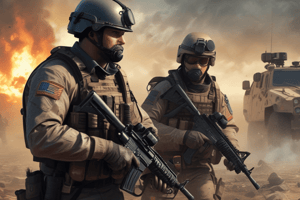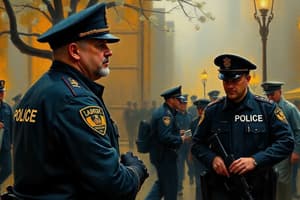Podcast
Questions and Answers
According to the policy, when should law enforcement officers use force?
According to the policy, when should law enforcement officers use force?
- When they want to assert their authority
- Whenever they see fit
- Only when no other alternatives exist (correct)
- Only when it's the easiest option
What is the definition of de-escalation as per the directive?
What is the definition of de-escalation as per the directive?
- Taking action to increase the immediacy of a threat
- Using minimal force in any encounter
- Communicating effectively in a non-force encounter (correct)
- Using force to control a situation
What does 'imminent danger' refer to?
What does 'imminent danger' refer to?
- Situations where force should not be used
- Potential dangers that are unlikely to happen
- Conditions or circumstances that cause harm immediately (correct)
- Circumstances that pose a potential danger in the distant future
According to the policy, what should law enforcement officers prioritize when using force?
According to the policy, what should law enforcement officers prioritize when using force?
What is the definition of lethal force?
What is the definition of lethal force?
What is the determination based upon when using force and the level of force used?
What is the determination based upon when using force and the level of force used?
According to the Florida law, when is an LEO justified in using force?
According to the Florida law, when is an LEO justified in using force?
What should an LEO consider when making the decision whether to use lethal force?
What should an LEO consider when making the decision whether to use lethal force?
Under what circumstances can an LEO use lethal force?
Under what circumstances can an LEO use lethal force?
What are some de-escalation techniques that an LEO should use before resorting to force?
What are some de-escalation techniques that an LEO should use before resorting to force?
According to Florida law, when should an LEO use de-escalation techniques?
According to Florida law, when should an LEO use de-escalation techniques?
What is the purpose of the Professional Standards Bureau (PSB) analysis of response to resistance incidents?
What is the purpose of the Professional Standards Bureau (PSB) analysis of response to resistance incidents?
What should an LEO use before resorting to force?
What should an LEO use before resorting to force?
In which situations is a supervisor not required to complete a Use of Force Report?
In which situations is a supervisor not required to complete a Use of Force Report?
Which factor should be considered when deciding to use force?
Which factor should be considered when deciding to use force?
What type of annual training must CSOs issued oleoresin capsicum (OC) spray receive?
What type of annual training must CSOs issued oleoresin capsicum (OC) spray receive?
What must an LEO allow before using force, if circumstances allow?
What must an LEO allow before using force, if circumstances allow?
When will the Professional Standards Bureau (PSB) conduct an annual analysis of all response to resistance incidents?
When will the Professional Standards Bureau (PSB) conduct an annual analysis of all response to resistance incidents?
What should an LEO consider when deciding whether to use physical force against individuals in restraints?
What should an LEO consider when deciding whether to use physical force against individuals in restraints?
What is the purpose of the Use of Force Report?
What is the purpose of the Use of Force Report?
What type of incidents require a supervisor to document in the Use of Force module?
What type of incidents require a supervisor to document in the Use of Force module?
What information does the Professional Standards Bureau (PSB) review during the annual analysis?
What information does the Professional Standards Bureau (PSB) review during the annual analysis?
When do LEOs receive annual training on response to resistance policies and procedures?
When do LEOs receive annual training on response to resistance policies and procedures?
When are employees involved in a critical or traumatic incident eligible for administrative leave?
When are employees involved in a critical or traumatic incident eligible for administrative leave?
What should an LEO do when reaching into a stationary vehicle with the engine running?
What should an LEO do when reaching into a stationary vehicle with the engine running?
Under what circumstances can an LEO use lateral vascular neck restraints or chokeholds?
Under what circumstances can an LEO use lateral vascular neck restraints or chokeholds?
When may a Community Service Officer (CSO) attempt to make a physical arrest?
When may a Community Service Officer (CSO) attempt to make a physical arrest?
When can an LEO unholster and/or display a sidearm?
When can an LEO unholster and/or display a sidearm?
In what order should an LEO's concerns be when approaching and/or arresting a suspect?
In what order should an LEO's concerns be when approaching and/or arresting a suspect?
Under what circumstances should an LEO use lateral vascular neck restraints or chokeholds?
Under what circumstances should an LEO use lateral vascular neck restraints or chokeholds?
What should an LEO do after using force on an individual?
What should an LEO do after using force on an individual?
When shall CSOs or CSTs use physical force?
When shall CSOs or CSTs use physical force?
What is the definition of 'less-lethal force' as per the given text?
What is the definition of 'less-lethal force' as per the given text?
When can a law enforcement officer use 'lethal force' according to the text?
When can a law enforcement officer use 'lethal force' according to the text?
What does 'imminent danger' refer to based on the given information?
What does 'imminent danger' refer to based on the given information?
What is the purpose of 'impact munition' as described in the text?
What is the purpose of 'impact munition' as described in the text?
What does 'de-escalation' involve?
What does 'de-escalation' involve?
What does 'imminent danger' refer to based on the given information?
What does 'imminent danger' refer to based on the given information?
Flashcards are hidden until you start studying




